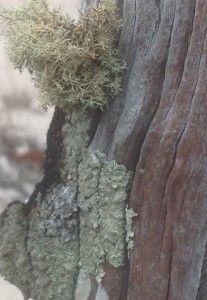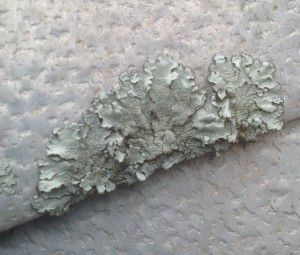Unlike true plants lichen are not single organisms but a symbiosis or partnership between a fungus, an algae and/or cyanobacteria.

Three different Lichen on a Jam Post
Fungus don’t contain chlorophyll to photosynthesise and make carbohydrates. Some fungi have taken to farming green algae for carbohydrate and cyanobacteria for nitrogen. The algal bacteria (
photobionts) are protected within the body of the fungus called the Thallus. The Thallus is composed of photobionts within a loose weave of fungal hyphae. The Thallus is protected by the Cortex, a tough outer layer composed of compacted fungal hyphae. Lichen anchor to the substrate by hyphae called Rhizines.
Lichen are found worldwide, from ice covered regions to deserts. They are able to grow on any natural substrate and many manufactured substrates such as concrete, glass and metal.

Lichen on aluminium
Lichen Growth Forms
Crustose: A thin layer of growth firmly attached to the substrate. For example the Orange and black stains on rocks. The lichen body is within the rock we only see the fruiting bodies.
Foliose: Sheet-like with many leafy lobes. Quite often seen growing on bark and stumps. May have one or many Rhizines.
Fruticose: Either erect like little trees or pendulous hanging structures. These lichen are almost round in cross section and are usually attached centrally to the substrate.
Leave A Comment